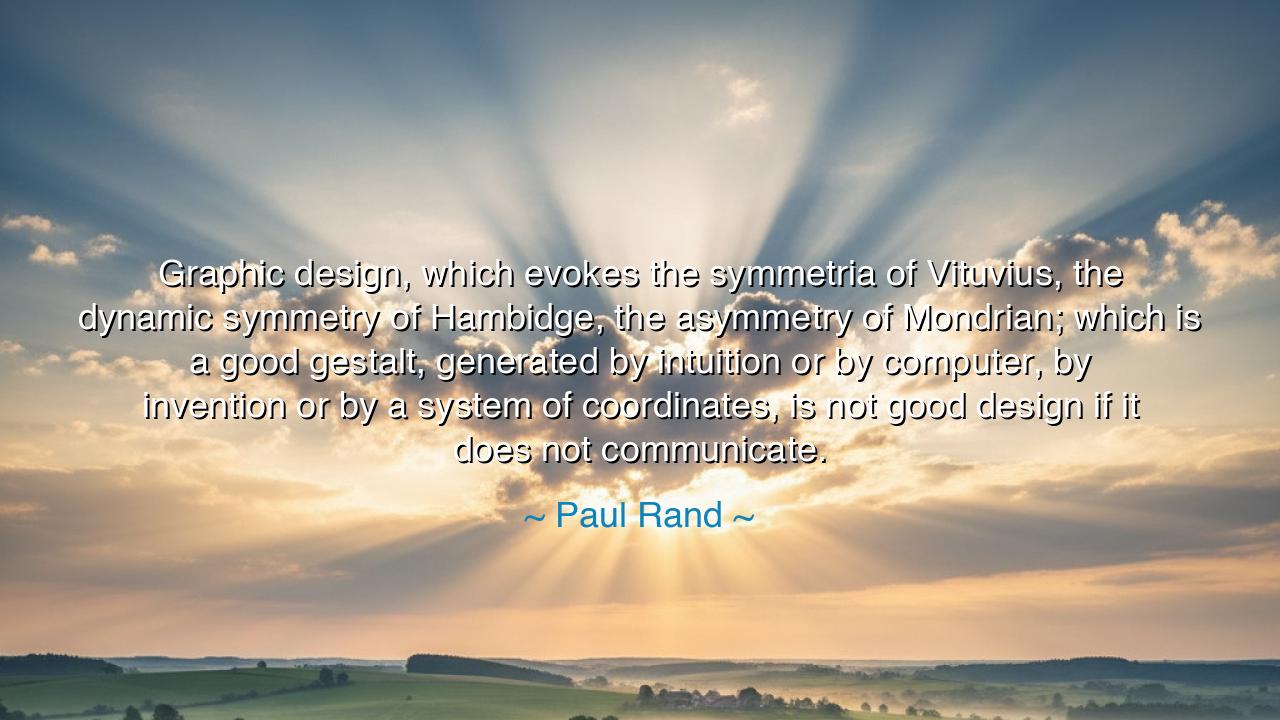
Graphic design, which evokes the symmetria of Vituvius, the
Graphic design, which evokes the symmetria of Vituvius, the dynamic symmetry of Hambidge, the asymmetry of Mondrian; which is a good gestalt, generated by intuition or by computer, by invention or by a system of coordinates, is not good design if it does not communicate.






The legendary designer Paul Rand, whose work bridged the worlds of art and intellect, once wrote: “Graphic design, which evokes the symmetria of Vitruvius, the dynamic symmetry of Hambidge, the asymmetry of Mondrian; which is a good gestalt, generated by intuition or by computer, by invention or by a system of coordinates, is not good design if it does not communicate.” In these words, Rand speaks not only as a craftsman of form, but as a philosopher of meaning. He reminds us that design, no matter how balanced, mathematical, or beautiful, fails in its purpose if it cannot communicate — if it does not speak to the mind, stir the heart, or convey truth with clarity and grace.
To understand this profound statement, we must look to the origin of Rand’s thought — the meeting point of classical proportion and modern abstraction. He calls upon the wisdom of Vitruvius, the ancient Roman architect whose treatise De Architectura taught that all good design must embody symmetria — the harmony of parts within a unified whole. Rand also invokes Jay Hambidge, the theorist of dynamic symmetry, who believed that art and design derive their vitality from the natural ratios found in shells, leaves, and galaxies. Then comes Piet Mondrian, the painter of pure form, who sought spiritual balance through the asymmetry of line and color. In naming these masters, Rand shows reverence for design as a universal language — one governed by geometry, intuition, and rhythm. Yet, even with all their brilliance, he insists that these principles mean nothing if they do not serve the higher goal of communication.
In this way, Paul Rand stands as a bridge between eras — between the sacred geometry of the ancients and the technological precision of the modern age. He lived through a century of transformation, when computers began to replace compasses, and design evolved from handcraft to digital art. Yet even as tools changed, he saw one eternal truth: that the purpose of design is not decoration but dialogue. The designer’s task is not to display skill or to please the eye alone, but to convey meaning — to translate thought into visible form, idea into experience. Without communication, he warns, design becomes a hollow shell — beautiful perhaps, but empty of soul.
Consider one of Rand’s most enduring creations: the IBM logo. It is nothing more than a set of bold, blue letters broken by horizontal stripes — simple, almost austere. Yet within that simplicity lies power. The rhythm of the lines suggests speed and modernity; the balance of weight conveys stability; the color evokes trust. It is not the symmetry alone that makes it timeless, but its clarity — its ability to speak across languages and generations. It communicates what IBM stands for without a single word. Here lies Rand’s truth in practice: that perfection of form serves the message, not the maker.
This philosophy echoes far beyond the realm of graphic design. In every art — in music, writing, architecture, even in human relationships — form without communication is vanity. The song that dazzles with technique but fails to move the listener, the speech that flourishes with rhetoric but lacks sincerity, the building that astonishes but alienates — all are empty victories. The ancients knew this as the harmony between logos (reason) and pathos (feeling): that the highest creation unites intellect and empathy. As Rand declares, true design is not measured by complexity, but by connection.
His words also contain a warning for the age of machinery. He saw a time coming when computers would allow endless variation, when systems and coordinates could generate perfect compositions. Yet perfection of structure does not ensure perfection of meaning. The designer, like the philosopher or poet, must never surrender to the machine; he must preserve the human element — intuition, empathy, and moral purpose. A design born without feeling may impress the eye but will never touch the spirit. Thus, Rand’s dictum stands as a defense of the soul in the age of automation: design must communicate, or it ceases to be alive.
So, my listener of the future, heed this wisdom of Paul Rand: whatever you create — be it an image, an invention, a message, or a life — let it speak. Do not hide behind symmetry or style; let your work be an act of connection. Craft it with intelligence, but breathe into it the warmth of meaning. For beauty without understanding is fleeting, but communication endures.
And remember this truth as sacred law: form is the vessel, but message is the life within it. Build your designs, your words, your deeds upon both — upon the harmony of structure and the clarity of intent. Only then will your work, like Rand’s, transcend time and technology to become what all true design must be — not a display of artifice, but a conversation between minds, across generations, carried in the eternal language of communication.






AAdministratorAdministrator
Welcome, honored guests. Please leave a comment, we will respond soon